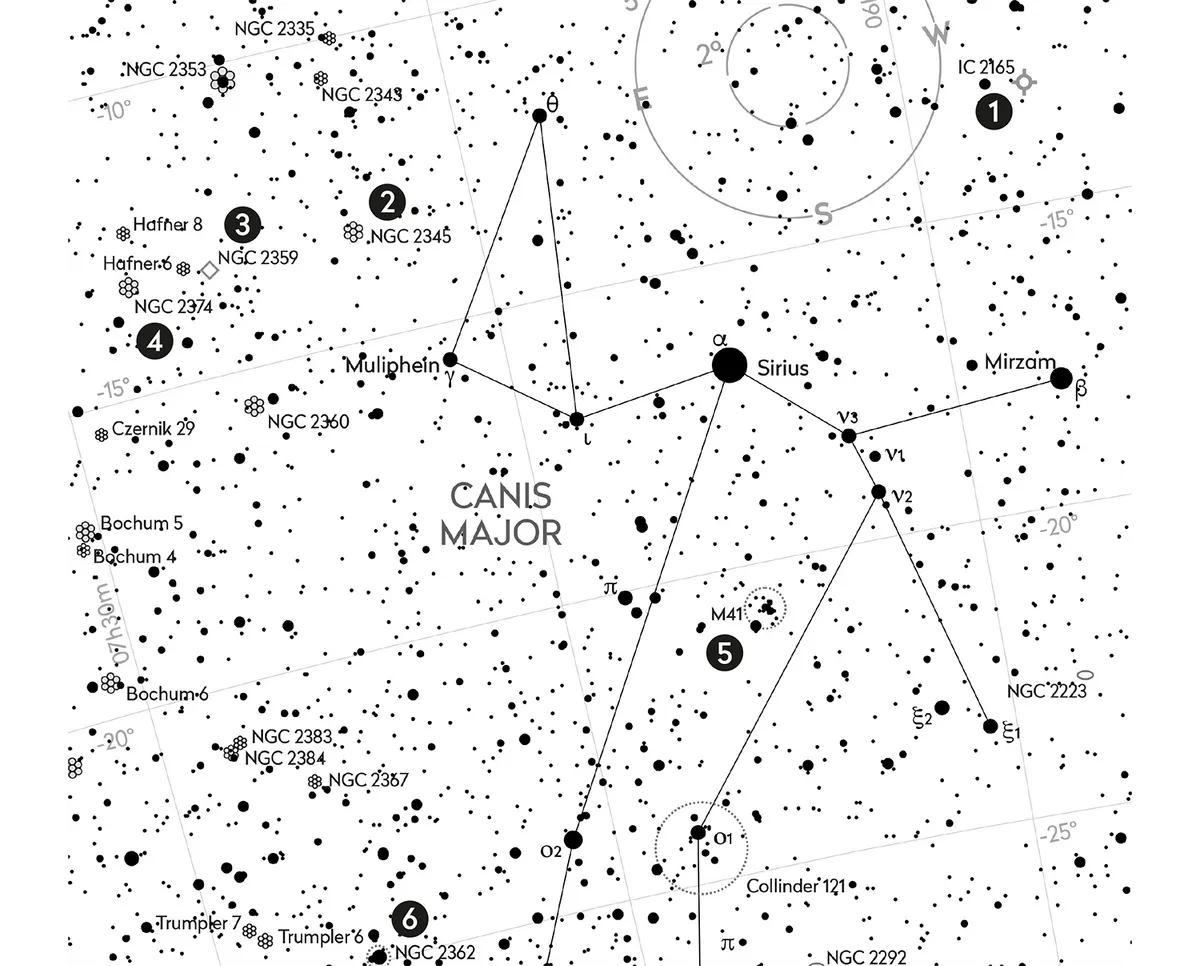In this deep-sky tour, we're locating the celestial delights in the constellation of Canis Major, including Thor's Helmet and the Mexican Jumping Bean Cluster.
Download a printable PDF of this tour here.
1
IC 2165
We start with a tiny planetary nebula catalogued as IC 2165, located 5˚ north of mag. +2.0 Mirzam (Beta (β) Canis Majoris). The term ‘planetary’ is well suited here as the nebula appears as a 9 arcsecond - i.e. planetary scale -grey disc. It shines at mag. +10.6 and, due to its size, is easy to overlook if using lower powers. An OIII filter can help with its identification. ο SEEN IT
2
NGC 2345
Our next target has the unforgettable catalogue number NGC 2345. To locate it we need to move to the east of Canis Major’s triangular head, formed from Gamma (γ), Iota (ι) and Theta (θ) Canis Majoris. It sits 2.5˚ north and 1˚ east of Gamma (γ) Canis Majoris. This mag. +7.7 open cluster is located within the boundary of the Milky Way, appearing against a rich background of faint stars.
A small scope shows around a dozen stars within a hazy patch. A 250mm scope ups it to about 30 stars, while a 300mm scope pushes the count to around 50. An attractive arch of mag. +10–11 orange stars sits in the centre of the cluster. ο SEEN IT
3
NGC 2359
NGC 2359 is an emission nebula unofficially known as Thor’s Helmet, an apt description because its overall appearance is of a domed ‘helmet’ with faint ‘wings’ either side (see the image at the top of this article. It’s formed partially from ionised gas irradiated by a Wolf-Rayet star known as WR7. Wolf-Rayet stars are incredibly hot, having lost much of their outer hydrogen to leave a helium-burning core.
Thor’s Helmet lies 2.5˚ east of NGC 2345 and is best suited for 150mm or larger instruments, although we’d recommend a 250mm scope.The first part of the nebula evident through the eyepiece is a rectangular east-west glow. This is one of the helmet’s wings. The helmet itself is created from a nebula bubble that sits north of the rectangular glow. The bubble presents itself as a ring visually, with a brighter arc close to its interface with the brighter wing

4
NGC 2374
We keep the line going from NGC 2345 through NGC 2359 for a distance of 1.3˚ to arrive at out next target, the eighth magnitude open cluster NGC 2374. A 150mm scope shows about 25 stars spread fairly evenly over a 5 arcminute region, elongated in a northeast to southwest manner.
Like our previous two targets, NGC 2374 lies within the boundary of the background Milky Way and this does make it tricky to see where the cluster stops and the background begins.
5
M41
M41 has no difficulty standing out from the crowd. This is a beauty of the winter sky, often overlooked because from the UK it’s low. However, it’s easy to locate M41 as it lies 4˚ south of Sirius (Alpha (α) Canis Majoris). The cluster has a visual magnitude of +4.5, which makes it a naked-eye object.
A small scope reveals a rich object containing around 50 stars brighter than mag. +12.0 spread across an area of similar size to that subtended by a full Moon (30 arcminutes across). Larger instruments extend the richness and size of the cluster to an apparent diameter around 45 arcminutes. A lovely combination of colours can be seen here too, some orange stars mixed in with a majority of blue white stars.
6
NGC 2362
For the final target we head south to mag. +4.3 Tau (τ) Canis Majoris, a triple star 8.5˚ southeast of M41 and 2.8˚ northeast of Wesen (Delta (δ) Canis Majoris). The object we’re after surrounds Tau, an open cluster known as NGC 2362 (sometimes known as the Tau Canis Majoris Cluster.) The brightness of Tau causes interference with the view, but perseverance pays off as the cluster is rich.
A 250mm scope shows around 40 stars in close proximity to Tau. The real fun starts when you centre Tau in the field of view and tap the side of your scope. The fainter stars appear to stop moving while Tau keeps bouncing, an effect caused by persistence of vision. This peculiar effect gives it the unofficial nickname of the Mexican Jumping Bean Cluster.

